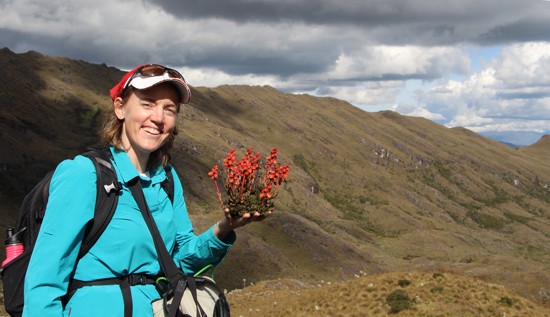Way up in the Andes Mountains, Suzette Flantua found a scarlet-colored flower that grows in only one place on Earth: where she stood, on an island in the sky. The island is a páramo—one of a string of grassland habitats in the Andes where the number of plant species is sky-high.
There are other mountainous areas with similar levels of species diversity, such as East Africa and New Guinea, but none of those other sky islands compare to the Andes. “These páramos are the most species rich of them all,” said Flantua, a paleoecologist at the University of Bergen in Norway.

One force behind the high diversity, Flantua and a team of researchers found, is that the páramos flicker. Like discrete puddles that fill and form one pond after a rainstorm, habitat connectivity in the páramos will join and break apart.
“The flickering is the connecting and disconnecting of the páramos,” Flantua said.
The páramos do this again and again. They disjoin, and new species evolve on the new islands, and when the islands rejoin, the new species move to new places and boost species diversity in that region. (The flower that Flantua found might be an example of this. “This species is not very well described, so we might have a new species at hand,” she said.)
To find the flickering, Flantua and her team, which reported on the phenomenon in June in the Journal of Biogeography, studied a 580-meter-long sediment core from Funza, Colombia, the site of an ancient Andean lake that does not exist anymore. The team studied the record of plant pollen preserved in the core, and they saw changes in the kinds of pollen that were there over the past million years.
When it was warm, pollen from arboreal plants became common, and when it was cold, pollen from alpine plants became common. The team made a video that shows how, over time, depending on whether the climate is hot or cold, the páromos flicker as the tree line moves up and down, making and unmaking the sky island chain.
Growing Sky Islands
The Andes are young mountains as far as mountains go; they began forming about 10 million years ago and did not reach the heights needed for páramos to develop—between about 2,800 and 4,300 meters in elevation—until about 3 million years ago.
“It’s a real recent habitat, and yet it’s got like half of the species for all of the tropical Americas.”
“These páramo habitats are thought to have been created when the Andean mountaintops peaked up above where trees could survive,” said Christopher Dick, an evolutionary biologist at the University of Michigan who was not involved in the study. “It’s a real recent habitat, and yet it’s got like half of the species for all of the tropical Americas.”
The mountains made the páramos possible, but Dick added that it’s now clear that having mountains is not the only thing needed for high species diversity. This is why Flantua wants to study the mountainous regions of places like East Africa to see whether the same flickering phenomenon is at work.
It’s still unclear if the páramos will sink into the sky.
As the climate is warming today, Flantua and her team also want to know how the páramos will react to a hotter world. The páramos climb high when the world is hot, and the thought is that the páramos will climb so high that they will climb themselves out of existence—the opposite of an ocean island sinking into the waves.
“There have been several phases that were warmer than we have today,” Flantua said, and the páramos are still here. But for now it’s still unclear if the páramos will sink into the sky or if today’s warming will lead to just another flicker.
—Lucas Joel, Freelance Journalist
Citation:
Joel, L. (2019), The flickering sky islands, Eos, 100, https://doi.org/10.1029/2019EO129823. Published on 02 August 2019.
Text © 2019. The authors. CC BY-NC-ND 3.0
Except where otherwise noted, images are subject to copyright. Any reuse without express permission from the copyright owner is prohibited.

